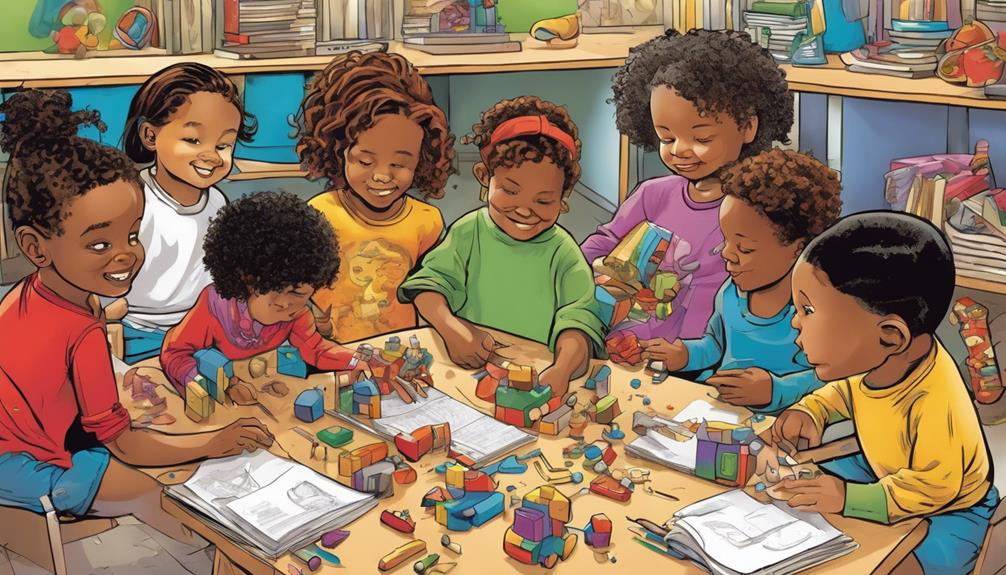To ensure that your child’s development thrives, adopt holistic approaches such as storytelling and games to enhance cognitive skills and motor development. Integrate play, exposure to nature, and painting for well-rounded growth. Stay attuned to emotions, utilize inquiry-based techniques, and monitor behavior for personalized instruction. Keep in mind that play is essential for fostering creativity, problem-solving, and social skills. Effective observation, from individualized education to additional support, assists in adjusting strategies. Build strong connections with families to cultivate a supportive community. These methods establish a comprehensive environment that promotes success. Discover more insights on this exciting journey of nurturing child development!
Key Takeaways
- Incorporate diverse activities for holistic development.
- Use responsive teaching techniques tailored to each child.
- Prioritize play for creativity, problem-solving, and social skills.
- Observe, adapt, and provide support as needed.
- Build strong relationships with families for consistent development.
Holistic Development Approaches

Engaging children in a variety of activities that stimulate cognitive, emotional, social, and physical development is essential for their holistic growth.
Stories and songs can spark imagination and boost cognitive skills. Games and play help refine sensory organs and motor skills.
Exposure to nature enriches mental development, while painting nurtures creativity and cognitive abilities.
By incorporating activities that cater to emotional, social, physical, and intellectual aspects, children are equipped with a well-rounded skill set for life's challenges.
Responsive Teaching Techniques

Utilizing responsive teaching techniques is crucial for fostering children's learning and development effectively. By understanding their emotions and thoughts, you can tailor your teaching to meet their individual needs.
Leveraging inquiry-based learning and asking open-ended questions will encourage critical thinking and analytical skills. When you extend parent or teacher talk time, you cultivate trust and creativity in children.
Observing their behaviors and responding to their questions and emotions will further enhance their learning experience. Adapting teaching methods to changing learning environments is essential for continued growth.
Importance of Play in Development

To further enhance children's development, exploring the significance of play in fostering their growth is essential. Play is not just a fun pastime; it is an important component in a child's holistic development. Through play, children enhance their physical, cognitive, and social skills while enjoying their childhood to the fullest. Check out the table below to see the diverse benefits of play in child development:
| Benefits of Play in Child Development | Examples |
|---|---|
| Enhances creativity | Building with blocks |
| Develops problem-solving skills | Solving puzzles |
| Improves social interactions | Playing group games |
| Boosts physical health | Running and jumping |
| Fosters imagination | Engaging in pretend play |
Engage your child in various forms of play to promote their well-rounded growth and development.
Effective Observation and Adaptation

Observing children's behaviors regularly is essential for tailoring educational strategies effectively to meet their individual needs. By paying close attention to how they interact, play, and learn, you can adapt your teaching methods to suit their unique styles.
For example, if you notice a child struggling with a particular task, you can provide additional support or offer alternative approaches to help them succeed. Similarly, if you see a child excelling in a certain area, you can tailor activities to further enhance their skills and knowledge.
Being observant allows you to be proactive in addressing challenges and maximizing opportunities for growth. Remember, every child is different, and by being attentive and adaptable, you can create a more engaging and enriching learning experience for each one.
Building Strong Relationships

Developing strong connections with families and educators is essential for supporting a child's holistic growth and learning journey. Collaborating with families not only creates a sense of community but also guarantees that everyone is working towards the same goal – the child's success.
By fostering trust and communication between educators and parents, you create a supportive network that enhances children's development. Involving families in educational decisions benefits children by providing a consistent and cohesive approach to their learning.
Establishing strong partnerships contributes to a child's holistic growth by creating a smooth shift between home and school environments. Remember, teamwork makes the dream work when it comes to nurturing a child's development!
Play-Based Learning Environments

Creating engaging play-based learning environments fosters holistic development in children by encouraging exploration and discovery through hands-on experiences. Play isn't just fun; it's a powerful tool for learning!
Imagine a child building a tower with blocks – they're not just stacking, they're developing spatial awareness and problem-solving skills. When children engage in imaginative play, like pretending to be a chef in a pretend kitchen, they're enhancing their creativity and language skills.
Play-based learning environments also promote social interactions; think about a group of kids collaborating to build a fort – they're learning teamwork and communication.
Intentional Teaching Strategies

To enhance children's overall development, employing intentional teaching strategies is key in promoting purposeful learning experiences aligned with their knowledge and interests.
By being intentional in your teaching approach, you can create a stimulating environment that caters to each child's unique needs and strengths.
Consider incorporating activities that spark curiosity, such as science experiments, art projects, or nature walks, to engage children in meaningful learning.
Encourage exploration and critical thinking by asking thought-provoking questions and providing opportunities for hands-on experiences.
Remember, intentional teaching isn't just about what you teach but how you teach it.
Frequently Asked Questions
How Can Technology Be Integrated Into Holistic Development Approaches?
You can integrate technology into holistic development by using educational apps for cognitive growth, virtual experiences for sensory development, and interactive platforms for social skills. Embrace technology as a tool to enhance child development.
What Are Some Strategies for Handling Challenging Behaviors in Responsive Teaching?
When handling challenging behaviors in responsive teaching, focus on empathy and positive reinforcement. Address emotions calmly, set clear boundaries, and offer alternatives. Encourage open communication and problem-solving. Consistent and patient approaches build trust and promote growth.
How Can Parents Support Play-Based Learning at Home?
To support play-based learning at home, you can create a diverse environment with toys and activities, engage in imaginative play with your child, encourage exploration and discovery, and provide opportunities for both structured and unstructured playtime.
What Are Effective Ways to Document and Analyze Observations in Child Development?
Document and analyze observations in child development by recording behaviors, noting strengths and weaknesses, and tailoring educational strategies. Respond to questions and emotions, adapt to changing environments, and plan purposeful experiences aligned with developmental stages for effective analysis.
How Can Intentional Teaching Strategies Be Tailored for Children With Special Needs?
Tailor intentional teaching strategies for children with special needs by understanding their unique requirements. Implement personalized approaches that cater to their developmental stages. Create a supportive environment that fosters their growth and well-being effectively.
Conclusion
To sum up, by embracing a variety of effective strategies such as storytelling, play, and building strong relationships, you can help children reach for the stars in their development journey.
Remember, a sprinkle of creativity, a dash of patience, and a whole lot of love are the secret ingredients to nurturing young minds.
So go forth, ignite their curiosity, and watch them soar to new heights with your guidance and support.
The possibilities are as endless as a unicorn's gallop!










